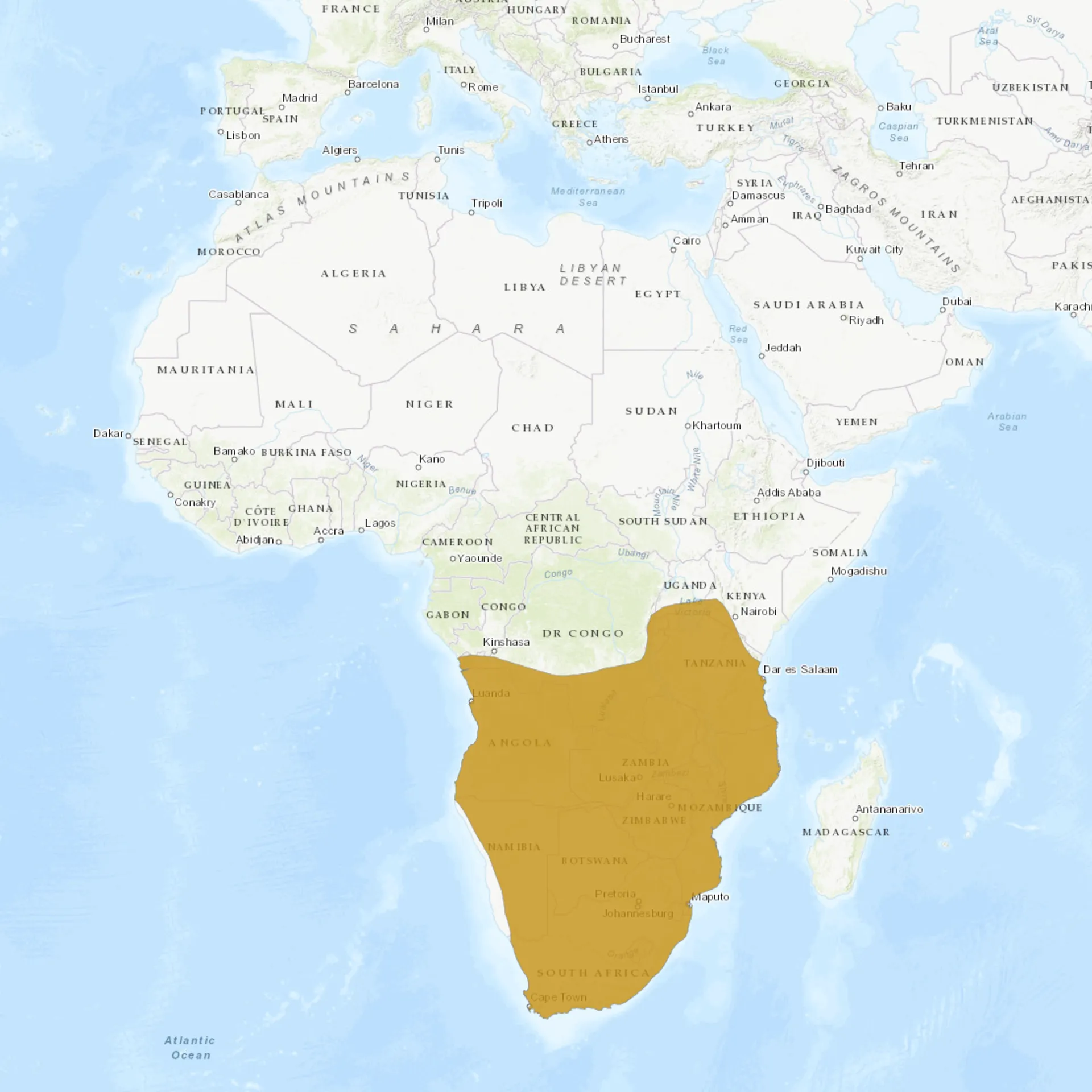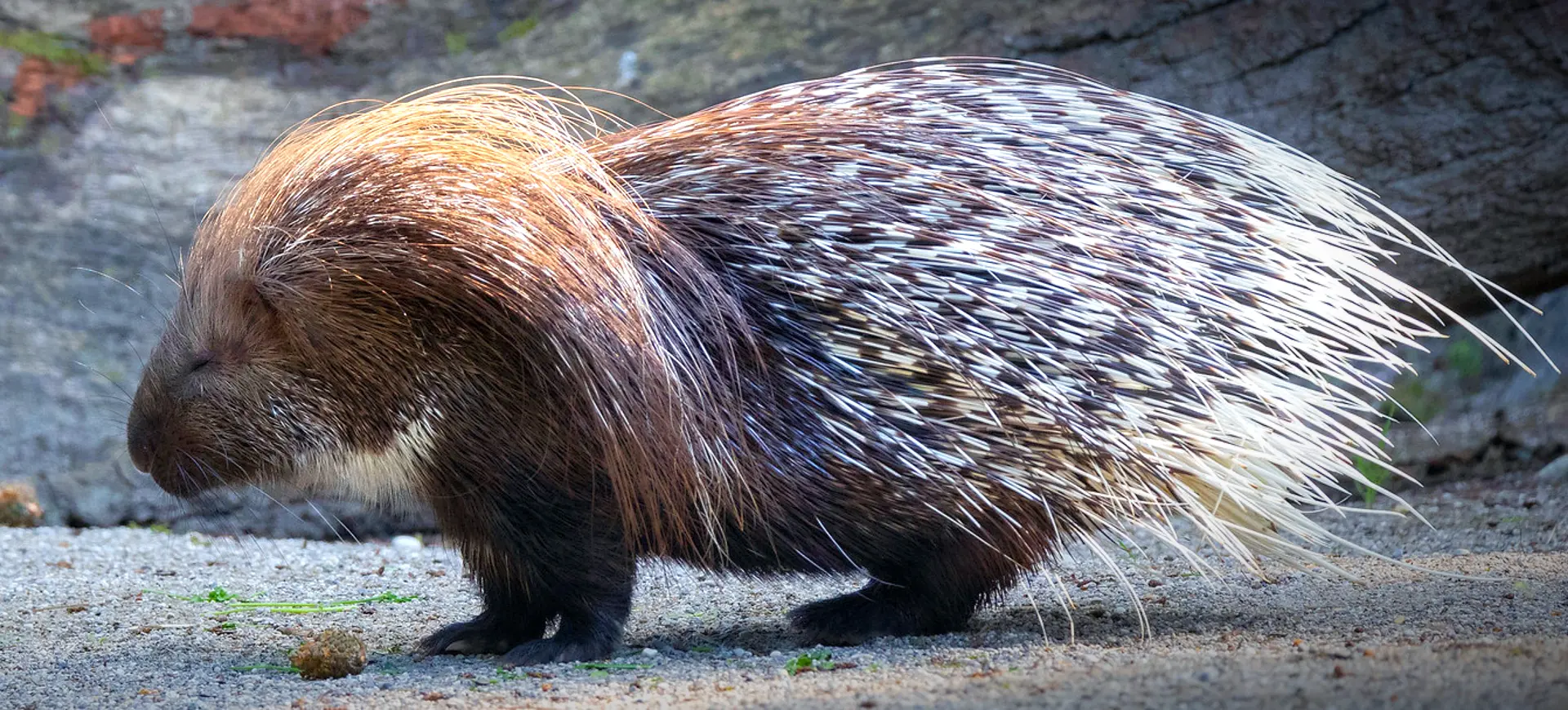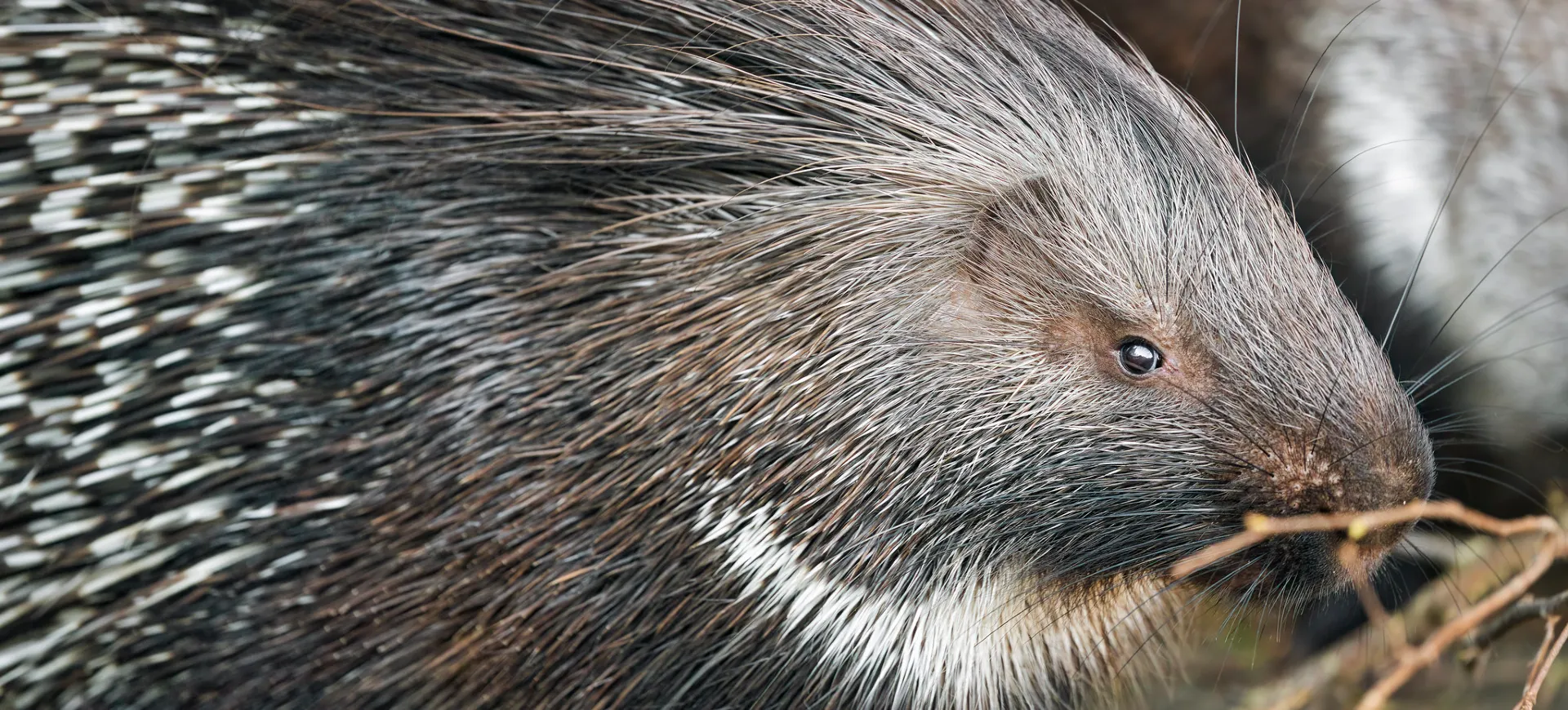Overview
The Cape porcupine (Hystrix africaeaustralis) is the largest porcupine species and one of Africa’s largest rodents. It is a nocturnal and terrestrial species found primarily in rocky and wooded areas across southern and central Africa. Known for its impressive quills, which can reach up to 20 inches (50 cm), the Cape porcupine uses these sharp, hollow spines to defend itself against predators. When threatened, it raises its quills, rattles them as a warning, and will charge backward to impale attackers if necessary.
Unlike many rodents, Cape porcupines are monogamous, forming long-term pair bonds with their mates. They dig complex burrow systems or modify abandoned burrows, creating underground shelters that protect them from predators and extreme temperatures. These highly adaptable porcupines can thrive in various environments, including savannas, forests, and semi-arid regions. Despite their slow and heavy appearance, they are strong diggers and can travel considerable distances for food.
Their diet consists mainly of plant material, including roots, tubers, bark, and fallen fruit, making them important seed dispersers in their ecosystems. They also gnaw on bones to supplement their diet with calcium, a behavior known as osteophagy. Due to their foraging habits, Cape porcupines can sometimes be seen as agricultural pests when they dig up crops. However, they are essential in maintaining healthy ecosystems by contributing to soil aeration and dispersal.
Taxonomy
Kingdom
Phylum
Class
Order
Family
Genus
Species
Type
Current distribution:
Cape porcupines are widely distributed across southern and central Africa, including South Africa, Namibia, Botswana, Zimbabwe, Mozambique, and parts of the Democratic Republic of the Congo. Their range extends into East Africa but is less common in extremely arid desert regions. They are highly adaptable and can be found in natural and agricultural landscapes, often near human settlements with abundant food sources. Despite some localized declines, they remain widespread and relatively abundant.
In areas where their habitat is being converted for farming, Cape porcupines are sometimes considered pests due to their tendency to dig up crops. They are also hunted for their meat and quills, which are used in traditional medicine and crafts. However, their ability to thrive in diverse habitats and their nocturnal lifestyle help them avoid excessive human interference. Conservation efforts focus on maintaining suitable habitats and mitigating human- wildlife conflict.
Physical Description:
The Cape porcupine is a large, stout-bodied rodent covered in long, sharp quills that provide a formidable defense against predators. These quills, which are modified hairs made of keratin, can be black and white banded or solid in color, with the longest ones forming a crest along its back. The shorter, sturdier quills on the lower body are used for protection, while the longer, hollow ones can produce a rattling sound as a warning signal. Their body fur is coarse and dark brown to black, contrasting with the lighter-colored quills.
They have a blunt, rounded head with small eyes and ears, adapted for a nocturnal lifestyle that relies more on scent and touch than vision. Their powerful front claws and strong limbs make them excellent diggers, allowing them to create extensive burrow systems. Unlike some rodents, their tail is short and covered in bristle-like quills rather than fur. Despite their stocky build, Cape porcupines are agile and capable of moving quickly when threatened.

Lifespan: Wild: ~15 Years || Captivity: ~20 Years

Weight: Male: 29–59 lbs (13–27 kg) || Female: 33–66 lbs (15–30 kg)

Length: Male: 24–33 in (60–85 cm) || Female: 25–36 in (64–91 cm)

Height: Male: 12–16 in (30–40 cm) || Female: 12–17 in (30–43 cm)

Top Speed: 6 mph (10 km/h)
Characteristic:
Native Habitat:
Cape porcupines inhabit various environments, including savannas, woodlands, grasslands, and rocky hillsides across southern and central Africa. They prefer areas with sufficient vegetation cover, where they can find food and shelter. Although they do not require permanent water sources, they are often found near rivers and streams where food is more abundant. Their ability to dig and modify burrows allows them to survive in regions with seasonal droughts.
They create extensive burrow systems or occupy abandoned burrows of other animals, providing protection from predators and extreme weather conditions. Instead of burrowing, they may seek shelter in caves, crevices, or dense undergrowth in rocky habitats. Their adaptability allows them to thrive in human-altered landscapes, including agricultural areas, where they forage on cultivated crops. However, habitat destruction and human conflict threaten their long-term survival in some regions.
Biomes:
Biogeographical Realms:
Continents:
Diet:
Diet & Feeding Habits:
Cape porcupines are herbivores whose diet mainly consists of roots, tubers, bark, and a variety of plant materials. They dig into the ground to access buried roots and bulbs, using their powerful claws to unearth food. In addition to plants, they chew on bones to obtain calcium and other minerals, which helps strengthen their quills and teeth. Their strong, ever-growing incisors enable them to gnaw through tough vegetation and tree bark efficiently.
These porcupines primarily forage at night, traveling long distances in search of food sources. While they mostly consume plant material, they occasionally eat cultivated crops, which can bring them into conflict with farmers. In food scarcity, they adapt by consuming various plant species, including dry vegetation and fibrous bark. In captivity, they are fed a mix of fruits, vegetables, and supplemental minerals to replicate their natural diet.
Mating Behavior:
Mating Description:
Cape porcupines are monogamous, forming long-term bonds with a single mate. The mating system is characterized by a strong pair bond, with both males and females participating in the care of their offspring. Mating can occur throughout the year, but peaks in mating activity are observed during the spring and autumn. The courtship process involves complex behaviors, including vocalizations, scent marking, and gentle quill contact.
After a successful mating, the female undergoes a gestation period lasting about three months, resulting in the birth of one to four offspring. The young, known as porcupines, are born with soft quills that harden a few hours after birth. These offspring are cared for in the burrow and remain with their parents for several months, learning essential survival skills before becoming independent. This extended family unit enhances their survival by providing protection and teaching foraging skills.
Reproduction Season:
Birth Type:
Pregnancy Duration:
Female Name:
Male Name:
Baby Name:
Social Structure Description:
Cape porcupines are known for their social structure, which revolves around family units comprised of a monogamous pair and their offspring. These family groups inhabit shared burrow systems, which serve as a haven against predators and a place to raise young. The social bonds within these groups are strong, with members communicating through various sounds, body language, and scent markings.
The cooperative nature of these family units is essential for survival, providing increased protection and efficiency in foraging. Adult porcupines are involved in the upbringing of their young, teaching them how to find food and defend themselves. This social structure not only aids in the survival of individual porcupines but also contributes to the stability of their populations.
Groups:
Conservation Status:
Population Trend:
The IUCN considers Cape porcupines the Least ConcernUCN, indicating a stable or large population. This status reflects their adaptability to various habitats and their ability to survive in both wild and modified landscapes. However, local populations may be affected by habitat destruction, hunting for quills and meat, and conflicts with agricultural interests.
Despite these challenges, Cape porcupines continue to maintain healthy populations in many areas, thanks to their reproductive strategy and the varied ecosystems they inhabit. Conservation efforts and protective legislation in some regions help mitigate the impacts of human activities, ensuring that Cape porcupines remain a common and resilient component of African fauna.
Population Threats:
Habitat destruction and fragmentation threaten Cape porcupine populations, particularly in areas undergoing rapid agricultural expansion or urbanization. These activities reduce the available habitat and fragment populations, limiting their movement and access to food. Hunting for their quills, used in traditional crafts and ornaments, and for their meat also poses a threat in some areas.
Conflicts with farmers, who consider them pests due to their tendency to feed on crops, can lead to targeted eradication efforts. While Cape porcupines are adaptable and capable of surviving in a range of environments, continuous pressure from human activities necessitates ongoing conservation efforts to ensure long-term survival.
Conservation Efforts:
Conservation strategies for Cape porcupines include habitat protection, research, and community engagement. Protected areas and national parks offer safe havens where they can live and breed without the immediate threats of habitat destruction and hunting. Research into their ecology and behavior helps inform conservation strategies, ensuring they are based on sound scientific principles.
Community-based conservation efforts aim to mitigate conflicts between farmers and porcupines, promoting coexistence through education and implementing non-lethal deterrents. These initiatives, combined with legal protections in some countries, contribute to the conservation of Cape porcupines, ensuring they continue to play their vital role in African ecosystems.
Additional Resources:
Fun Facts
- Cape porcupines are capable of causing serious injury to predators with their sharp quills.
- They gnaw on bones to sharpen their teeth and obtain minerals.
- Cape porcupines can eat up to 90% of their body weight in plant material in one night.
- Humans have used their quills for decorative purposes and in traditional medicine.
- Despite their formidable defense mechanisms, Cape porcupines are shy and will try to avoid confrontation.
- They have been observed using their quills to make noise to communicate.
- Cape porcupines are excellent swimmers.
- They are one of the few monogamous animals, with a pair bond lasting many years.
- The name “porcupine” comes from the Latin words for pig (porcus) and spine (spina), reflecting their spiky appearance.
- Their burrows can be extensive, with multiple entrances and chambers, and other animals can use them as shelter.












